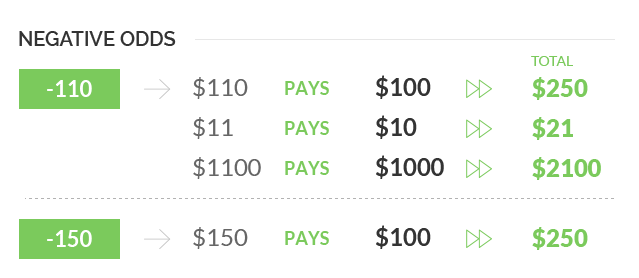Looking to learn how sports betting odds are determined? Well, you’re in the right place!
When it comes to sports betting, odds play a crucial role in determining the potential payouts and the likelihood of an outcome. But have you ever wondered how these odds are actually calculated?
In this article, we will take a closer look at the fascinating world of sports betting odds and unravel the mystery behind their determination. So, let’s dive right in and explore the inner workings of this captivating aspect of the sports betting industry.

How is Sports Betting Odds Determined?
Sports betting is a popular and exciting activity that involves wagering on the outcome of sporting events. To make informed bets, understanding how sports betting odds are determined is essential. Betting odds represent the probability of an event occurring and the potential payout if the bettor’s prediction is correct. In this article, we will explore the factors that influence sports betting odds and shed light on the intricate process of determining these odds.
Factors Influencing Sports Betting Odds
Several factors come into play when determining sports betting odds. These factors include:
The Probability of the Outcome
When it comes to sports betting, the probability of an outcome plays a crucial role in determining the odds. Sportsbooks assess the probability of a particular event happening based on various factors, including historical data, team or player performance, injuries, and the venue of the event. The more likely an outcome is to occur, the lower the odds offered by the sportsbook. Conversely, the less likely an outcome is, the higher the odds offered.
Bookmaker’s Margin
Bookmakers aim to make a profit, so they include a margin in the odds they offer. This margin ensures that the amount of money wagered exceeds the potential payouts, allowing the bookmaker to cover operational costs and make a profit. The bookmaker’s margin is often referred to as the vigorish or the “vig.” It is typically embedded within the odds and is calculated to ensure that the sportsbook maintains a balanced book and limits their exposure to potential losses.
Market Forces
In addition to probability and the bookmaker’s margin, sports betting odds can also be influenced by market forces. Market forces are determined by supply and demand. If a large number of bettors place wagers on a particular outcome, the odds for that outcome may decrease due to increased demand. Conversely, if there is less interest in a specific outcome, the odds may increase to attract more bettors. The sportsbook adjusts the odds based on the betting patterns of their customers to balance their liabilities.
Types of Sports Betting Odds
There are various types of sports betting odds formats used around the world. These formats include:
Decimal Odds
Decimal odds, also known as European odds, are the most popular format used in many countries, including Europe, Australia, and Canada. The odds are represented as positive numbers, and the decimal figure reflects the potential payout if the bet is successful. For example, a decimal odds of 2.5 means the bettor will receive 2.5 times their stake if they win their bet.
American Odds
American odds, also known as moneyline odds, are commonly used in the United States. These odds are represented as either positive or negative numbers. Positive odds indicate the potential profit a bettor can make on a $100 wager, while negative odds suggest the amount of money one would need to bet to win $100. For example, odds of +200 mean that a $100 bet would yield a $200 profit, while odds of -200 mean that a $200 bet is needed to win $100.
Fractional Odds
Fractional odds, often used in the United Kingdom, are represented as fractions. The first number in the fraction indicates the potential profit from a winning bet, while the second number represents the stake. For instance, fractional odds of 3/1 mean that a $1 bet would yield $3 in profit.
Conclusion
Determining sports betting odds involves various factors such as the probability of the outcome, the bookmaker’s margin, and market forces. Understanding these factors is crucial for bettors to make informed decisions. By considering the factors that influence odds and the different types of odds formats, bettors can navigate the world of sports betting with confidence and increase their chances of winning.
Key Takeaways: How is sports betting odds determined?
- Sports betting odds are determined by various factors such as team performance, player injuries, and historical records.
- Bookmakers use complex algorithms and statistical models to calculate the probabilities of different outcomes.
- Market demand and betting trends can also influence odds, as bookmakers adjust them to balance their books.
- Odds can change in real-time based on new information or unexpected events during a game.
- Understanding how odds are determined can help bettors make informed decisions and potentially increase their chances of winning.
Frequently Asked Questions
Here are some frequently asked questions about how sports betting odds are determined:
1. How do bookmakers calculate sports betting odds?
Bookmakers calculate sports betting odds by considering various factors such as the teams or individuals involved, their past performance, and the current market demand. They use statistical models and algorithms to analyze data and determine the probability of different outcomes. Based on this probability, they set the odds for each possible outcome.
The odds are designed to reflect the likelihood of an event happening and also to ensure that the bookmaker makes a profit regardless of the outcome. Bookmakers adjust the odds continually to manage their risk and account for any changes in the market or new information that may affect the outcome of the event.
2. What is the role of public opinion in determining sports betting odds?
Public opinion can influence sports betting odds to some extent. Bookmakers take into account the public’s perception of a team or player and adjust the odds based on that perception. If a team is popular and has a large fan base, bookmakers may adjust the odds to attract more bets on the opposing team and balance the books.
However, it’s important to note that bookmakers rely more on data and statistical models rather than public opinion when determining the odds. They aim to set odds that reflect the true probability of an outcome, regardless of public sentiment.
3. How do changes in betting volume affect sports betting odds?
Changes in betting volume can have an impact on sports betting odds. Bookmakers monitor the amount of money being wagered on different outcomes and adjust the odds accordingly. If there is a significant amount of money placed on one side of a bet, bookmakers may lower the odds for that outcome to attract more bets on the other side and balance their exposure.
Bookmakers aim to achieve a balanced book, meaning they want to have roughly equal amounts of money wagered on both sides of a bet, ensuring a profit regardless of the outcome. Changes in betting volume help them achieve this balance and manage their risk.
4. What role does past performance play in determining sports betting odds?
Past performance is an essential factor in determining sports betting odds. Bookmakers analyze the historical data of teams or individuals, including their previous matches, records, and performance metrics. They use this information to assess the overall strength and abilities of the teams or individuals involved and adjust the odds accordingly.
The past performance provides valuable insights into how a team or player is likely to perform in the future. However, bookmakers also take into account other factors such as injuries, changes in coaching staff, and recent form to make more accurate predictions and set the odds.
5. How do sports betting odds change over time?
Sports betting odds can change over time due to several factors. As new information becomes available, such as team news or injury updates, bookmakers may adjust the odds to reflect these changes in the predicted outcome. Additionally, as more bets are placed on a particular outcome, the bookmakers may adjust the odds to balance their exposure and manage their risk.
Moreover, the odds can also change based on market demand and fluctuations. If there is a sudden surge of bets on a specific outcome, bookmakers may shorten the odds for that outcome to limit their potential losses. Conversely, if there is less demand for a particular outcome, bookmakers may lengthen the odds to attract more bets and balance their book.
The Math Behind How Betting Odds Are Set | Mach | NBC News
Summary
So, how do they figure out the odds for sports betting? Well, it’s a mix of mathematics and analyzing data. The bookmakers use algorithms that consider various factors like team performance, player injuries, and historical data to calculate the odds. Then, they adjust the odds based on how people are betting to ensure a balanced book and to make a profit. Remember, though, sports betting is a game of chance, so it’s essential to gamble responsibly and know that you can win or lose.
Ultimately, understanding how odds are determined can give you insight into sports betting. It’s not just random numbers; there’s a lot more to it. So, next time you place a bet, you’ll have a better understanding of how the odds work. Just remember to have fun and gamble responsibly!
